SKODA OCTAVIA TOUR 2009 1.G / (1U) Owner's Manual
Manufacturer: SKODA, Model Year: 2009, Model line: OCTAVIA TOUR, Model: SKODA OCTAVIA TOUR 2009 1.G / (1U)Pages: 226, PDF Size: 13.11 MB
Page 151 of 226
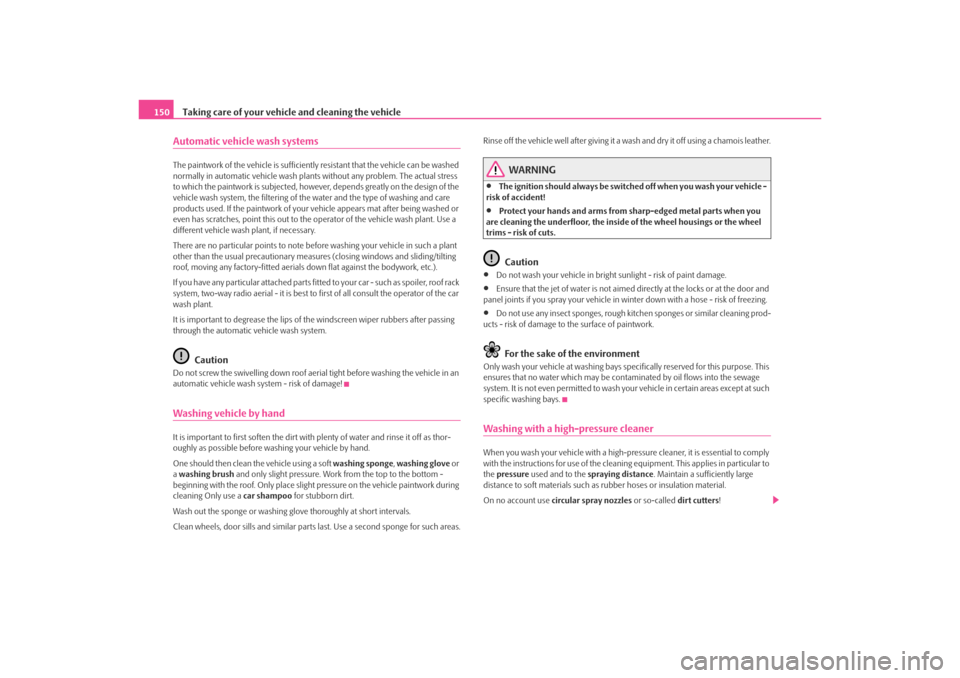
Taking care of your vehicle and cleaning the vehicle
150Automatic vehicle wash systemsThe paintwork of the vehicle is sufficiently resistant that the vehicle can be washed
normally in automatic vehicle wash plants without any problem. The actual stress
to which the paintwork is subjected, however, depends greatly on the design of the
vehicle wash system, the filtering of the water and the type of washing and care
products used. If the paintwork of your vehicle appears mat after being washed or
even has scratches, point this out to the operator of the vehicle wash plant. Use a
different vehicle wash plant, if necessary.
There are no particular points to note be fore washing your vehicle in such a plant
other than the usual precautionary measur es (closing windows and sliding/tilting
roof, moving any factory-fitted aerials down flat against the bodywork, etc.).
If you have any particular atta ch e d p a r t s f i t te d t o y o u r c a r - s u ch a s s p o i l e r, ro o f ra ck
system, two-way radio aerial - it is best to first of all consult the operator of the car
wash plant.
It is important to degrease the lips of the windscreen wiper rubbers after passing
through the automatic vehicle wash system.
Caution
Do not screw the swivelling down roof aeri al tight before washing the vehicle in an
automatic vehicle wash sy stem - risk of damage!Washing vehicle by handIt is important to first soften the dirt with plenty of water and rinse it off as thor-
oughly as possible before wa shing your vehicle by hand.
One should then clean the vehicle using a soft washing sponge, washing glove or
a washing brush and only slight pressure. Work from the top to the bottom -
beginning with the roof. Only place slight pressure on the vehicle paintwork during
cleaning Only use a car shampoo for stubborn dirt.
Wash out the sponge or washing glove thoroughly at short intervals.
Clean wheels, door sills and similar parts last. Use a second sponge for such areas. Rinse off the vehicle well after giving it a
wash and dry it off using a chamois leather.
WARNING
•
The ignition should always be switched off when you wash your vehicle -
risk of accident!
•
Protect your hands and arms from sharp-edged metal parts when you
are cleaning the underfloor, the inside of the wheel housings or the wheel
trims - risk of cuts.Caution
•
Do not wash your vehicle in bright sunlight - risk of paint damage.
•
Ensure that the jet of water is not aimed directly at the locks or at the door and
panel joints if you spray your vehicle in winter down with a hose - risk of freezing.
•
Do not use any insect sponges, rough ki tchen sponges or similar cleaning prod-
ucts - risk of damage to the surface of paintwork.For the sake of the environment
Only wash your vehicle at washing bays specifically reserved for this purpose. This
ensures that no water which may be cont aminated by oil flows into the sewage
system. It is not even permitted to wash your vehicle in certain areas except at such
specific washing bays.Washing with a high-pressure cleanerWhen you wash your vehicle with a high-pressure cleaner, it is essential to comply
with the instructions for use of the cleaning equipment. This applies in particular to
the pressure used and to the spraying distance. Maintain a sufficiently large
distance to soft materials such as rubber hoses or insulation material.
On no account use circular spray nozzles or so-called dirt cutters!
s2ig.book Page 150 Monday, November 10, 2008 11:20 AM
Page 152 of 226
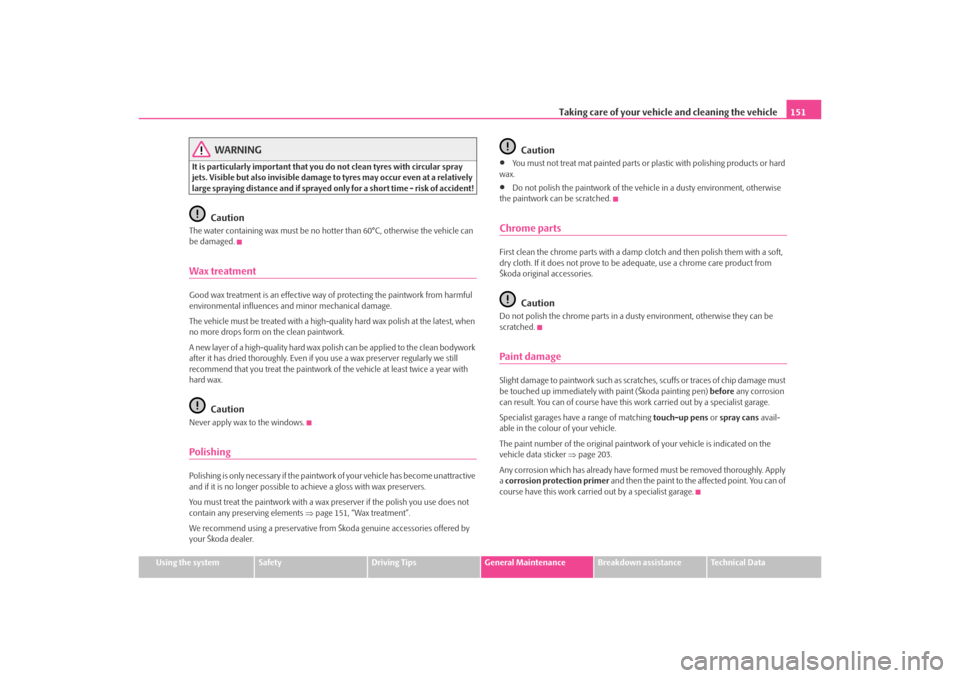
Taking care of your vehicle and cleaning the vehicle151
Using the system
Safety
Driving Tips
General Maintenance
Breakdown assistance
Technical Data
WARNING
It is particularly important that you do not clean tyres with circular spray
jets. Visible but also invisible damage to tyres may occur even at a relatively
large spraying distance and if sprayed only for a short time - risk of accident!
Caution
The water containing wax must be no hott er than 60°C, otherwise the vehicle can
be damaged.Wax treatmentGood wax treatment is an effective way of protecting the paintwork from harmful
environmental influences an d minor mechanical damage.
The vehicle must be treated with a high-qua lity hard wax polish at the latest, when
no more drops form on the clean paintwork.
A new layer of a high-quality hard wax polish can be applied to the clean bodywork
after it has dried thoroughly. Even if you use a wax preserver regularly we still
recommend that you treat the paintwork of the vehicle at least twice a year with
hard wax.
Caution
Never apply wax to the windows.PolishingPolishing is only necessary if the paintwor k of your vehicle has become unattractive
and if it is no longer possible to achieve a gloss with wax preservers.
You must treat the paintwork with a wax preserver if the polish you use does not
contain any preserving elements ⇒page 151, “Wax treatment”.
We recommend using a preservative from Škoda genuine accessories offered by
your Škoda dealer.
Caution
•
You must not treat mat painted parts or plastic with polishing products or hard
wax.
•
Do not polish the paintwork of the vehicle in a dusty environment, otherwise
the paintwork can be scratched.
Chrome partsFirst clean the chrome parts with a damp clotch and then polish them with a soft,
dry cloth. If it does not prove to be adequate, use a chrome care product from
Škoda original accessories.
Caution
Do not polish the chrome parts in a du sty environment, otherwise they can be
scratched.Paint damageSlight damage to paintwork such as scratche s, scuffs or traces of chip damage must
be touched up immediately with paint (Škoda painting pen) before any corrosion
can result. You can of course have this work carried out by a specialist garage.
Specialist garages have a range of matching touch-up pens or spray cans avail-
able in the colour of your vehicle.
The paint number of the orig inal paintwork of your vehicle is indicated on the
vehicle data sticker ⇒page 203.
Any corrosion which has already have formed must be removed thoroughly. Apply
a corrosion protection primer and then the paint to the affected point. You can of
course have this work carried out by a specialist garage.
s2ig.book Page 151 Monday, November 10, 2008 11:20 AM
Page 153 of 226
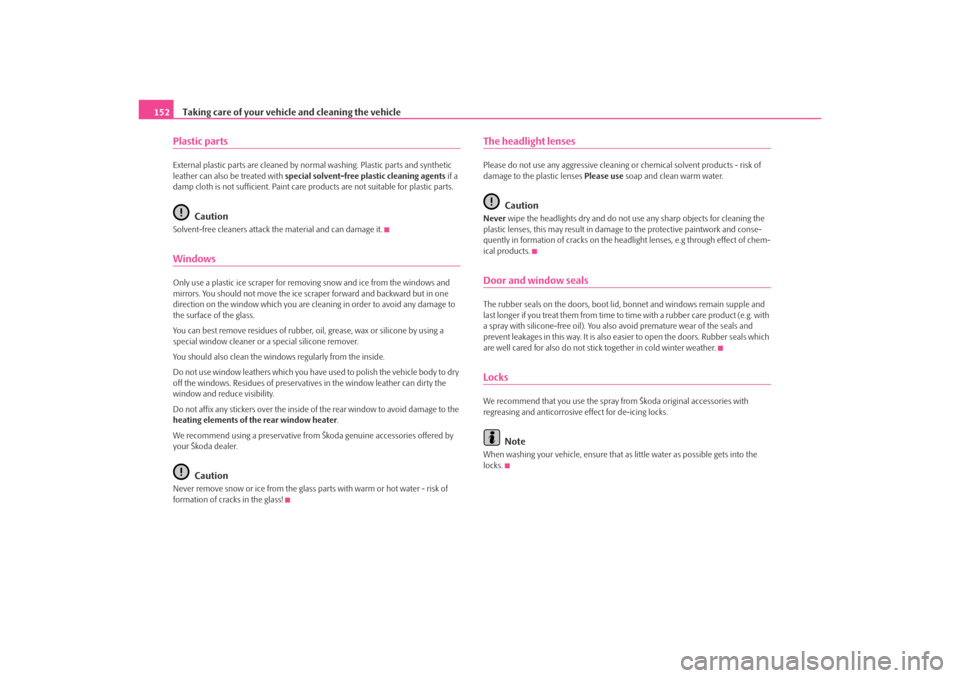
Taking care of your vehicle and cleaning the vehicle
152Plastic partsExternal plastic parts are cleaned by normal washing. Plastic parts and synthetic
leather can also be treated with special solvent-free plastic cleaning agents if a
damp cloth is not sufficient. Paint care pr oducts are not suitable for plastic parts.
Caution
Solvent-free cleaners attack the material and can damage it.WindowsOnly use a plastic ice scraper for removing snow and ice from the windows and
mirrors. You should not move the ice scraper forward and backward but in one
direction on the window which you are clea ning in order to avoid any damage to
the surface of the glass.
You can best remove residues of rubber, oil, grease, wax or silicone by using a
special window cleaner or a special silicone remover.
You should also clean the windows regularly from the inside.
Do not use window leathers which you have used to polish the vehicle body to dry
off the windows. Residues of preservati ves in the window leather can dirty the
window and reduce visibility.
Do not affix any stickers over the inside of the rear window to avoid damage to the
heating elements of the rear window heater .
We recommend using a preservative from Škoda genuine accessories offered by
your Škoda dealer.
Caution
Never remove snow or ice from the glass parts with warm or hot water - risk of
formation of cracks in the glass!
The headlight lensesPlease do not use any aggres sive cleaning or chemical solvent pr oducts - risk of
damage to the plastic lenses Please use soap and clean warm water.
Caution
Never wipe the headlights dry and do not use any sharp objects for cleaning the
plastic lenses, this may result in damage to the protective paintwork and conse-
quently in formation of cracks on the head light lenses, e.g through effect of chem-
ical products.Door and window sealsThe rubber seals on the doors, boot lid, bonnet and windows remain supple and
last longer if you treat them from time to time with a rubber care product (e.g. with
a spray with silicone-free oil). You also avoid premature wear of the seals and
prevent leakages in this way. It is also easier to open the doors. Rubber seals which
are well cared for also do not stick together in cold winter weather.LocksWe recommend that you use the spray from Škoda original accessories with
regreasing and anticorrosive effect for de-icing locks.
Note
When washing your vehicle, ensure that as little water as possible gets into the
locks.
s2ig.book Page 152 Monday, November 10, 2008 11:20 AM
Page 154 of 226
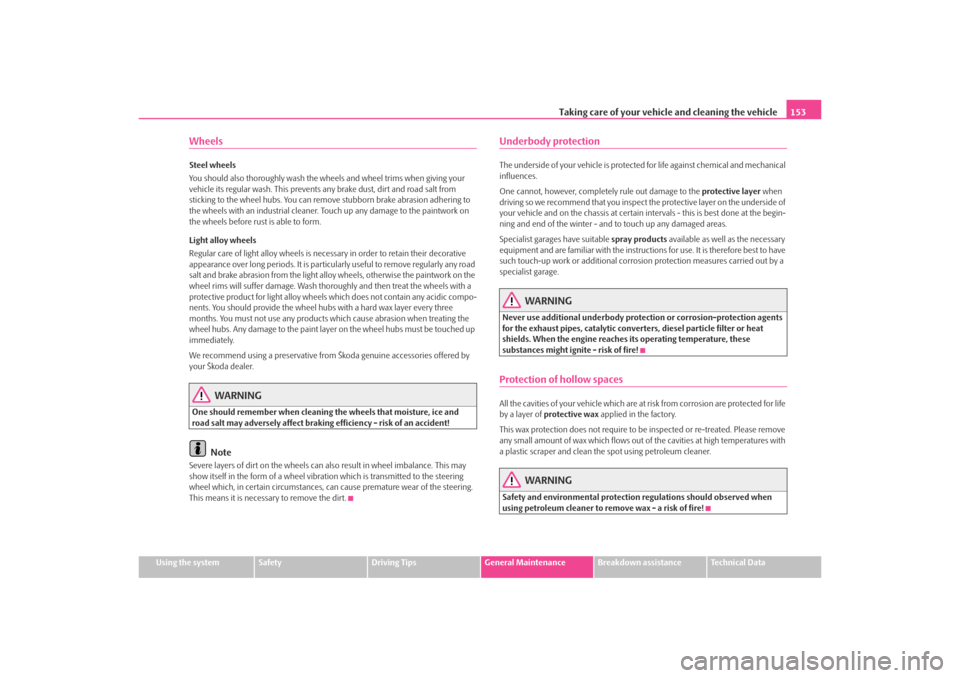
Taking care of your vehicle and cleaning the vehicle153
Using the system
Safety
Driving Tips
General Maintenance
Breakdown assistance
Technical Data
WheelsSteel wheels
You should also thoroughly wash the wheels and wheel trims when giving your
vehicle its regular wash. This prevents any brake dust, dirt and road salt from
sticking to the wheel hubs. You can remove stubborn brake abrasion adhering to
the wheels with an industri al cleaner. Touch up any damage to the paintwork on
the wheels before rust is able to form.
Light alloy wheels
Regular care of light alloy wheels is necessary in order to retain their decorative
appearance over long periods. It is partic ularly useful to remove regularly any road
salt and brake abrasion from the light alloy wheels, otherwise the paintwork on the
wheel rims will suffer damage. Wash thoroughly and then treat the wheels with a
protective product for light alloy wheels which does not contain any acidic compo-
nents. You should provide the wheel hu bs with a hard wax layer every three
months. You must not use any products which cause abrasion when treating the
wheel hubs. Any damage to the paint laye r on the wheel hubs must be touched up
immediately.
We recommend using a preservative from Škoda genuine accessories offered by
your Škoda dealer.
WARNING
One should remember when cleaning the wheels that moisture, ice and
road salt may adversely affect brakin g efficiency - risk of an accident!
Note
Severe layers of dirt on the wheels can also result in wheel imbalance. This may
show itself in the form of a wheel vibration which is transmitted to the steering
wheel which, in certain circumstances, ca n cause premature wear of the steering.
This means it is necessary to remove the dirt.
Underbody protectionThe underside of your vehicl e is protected for life against chemical and mechanical
influences.
One cannot, however, completely rule out damage to the protective layer when
driving so we recommend that you inspect the protective layer on the underside of
your vehicle and on the chassis at certain in tervals - this is best done at the begin-
ning and end of the winter - and to touch up any damaged areas.
Specialist garages have suitable spray products available as well as the necessary
equipment and are familiar with the instructions for use. It is therefore best to have
such touch-up work or additional corrosion protection measures carried out by a
specialist garage.
WARNING
Never use additional underbody protection or corrosion-protection agents
for the exhaust pipes, catalytic converte rs, diesel particle filter or heat
shields. When the engine reaches its operating temperature, these
substances might ignite - risk of fire!Protection of hollow spacesAll the cavities of your vehicle which are at risk from corrosion are protected for life
by a layer of protective wax applied in the factory.
This wax protection does not require to be inspected or re-treated. Please remove
any small amount of wax which flows out of the cavities at high temperatures with
a plastic scraper and clean the spot using petroleum cleaner.
WARNING
Safety and environmental protection regulations should observed when
using petroleum cleaner to re move wax - a risk of fire!
s2ig.book Page 153 Monday, November 10, 2008 11:20 AM
Page 155 of 226
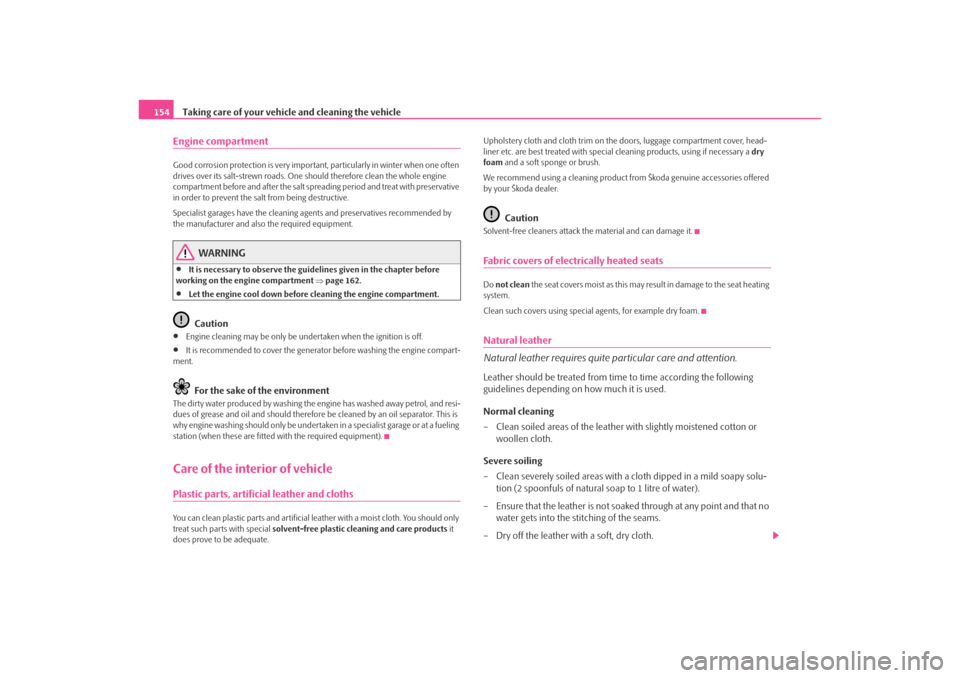
Taking care of your vehicle and cleaning the vehicle
154Engine compartmentGood corrosion protection is very importan t, particularly in winter when one often
drives over its salt-strewn roads. One should therefore clean the whole engine
compartment before and after the salt spre ading period and treat with preservative
in order to prevent the salt from being destructive.
Specialist garages have th e cleaning agents and preservatives recommended by
the manufacturer and also the required equipment.
WARNING
•
It is necessary to observe the guidelines given in the chapter before
working on the engine compartment ⇒page 162.
•
Let the engine cool down before cleaning the engine compartment.Caution
•
Engine cleaning may be only be und ertaken when the ignition is off.
•
It is recommended to cover the generator before washing the engine compart-
ment.For the sake of the environment
The dirty water produced by washing the engine has washed away petrol, and resi-
dues of grease and oil and should therefor e be cleaned by an oil separator. This is
why engine washing should only be undertake n in a specialist garage or at a fueling
station (when these are fitted with the required equipment).Care of the interior of vehiclePlastic parts, artificial leather and clothsYou can clean plastic parts and artificial leather with a moist cloth. You should only
treat such parts with special solvent-free plastic cleaning and care products it
does prove to be adequate. Upholstery cloth and cloth trim on the
doors, luggage compartment cover, head-
liner etc. are best treated with special cleaning products, using if necessary a dry
foam and a soft sponge or brush.
We recommend using a cleaning product from Škoda genuine accessories offered
by your Škoda dealer.
Caution
Solvent-free cleaners attack the material and can damage it.Fabric covers of electrically heated seatsDo not clean the seat covers moist as this may result in damage to the seat heating
system.
Clean such covers using special agents, for example dry foam.Natural leather
Natural leather requires quite particular care and attention.Leather should be treated from time to time according the following
guidelines depending on how much it is used.
Normal cleaning
– Clean soiled areas of the leather with slightly moistened cotton or
woollen cloth.
Severe soiling
– Clean severely soiled areas with a cloth dipped in a mild soapy solu- tion (2 spoonfuls of natural soap to 1 litre of water).
– Ensure that the leather is not soaked through at any point and that no water gets into the stitching of the seams.
– Dry off the leather with a soft, dry cloth.
s2ig.book Page 154 Monday, November 10, 2008 11:20 AM
Page 156 of 226
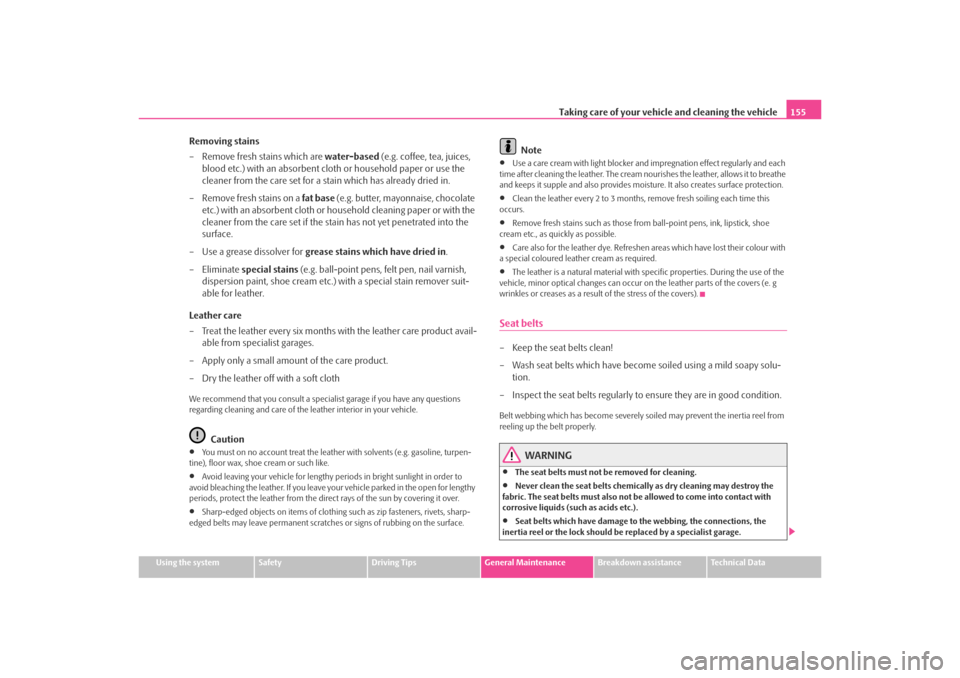
Taking care of your vehicle and cleaning the vehicle155
Using the system
Safety
Driving Tips
General Maintenance
Breakdown assistance
Technical Data
Removing stains
– Remove fresh stains which are water-based (e.g. coffee, tea, juices,
blood etc.) with an absorbent cloth or household paper or use the
cleaner from the care set for a stain which has already dried in.
– Remove fresh stains on a fat base (e.g. butter, mayonnaise, chocolate
etc.) with an absorbent cloth or household cleaning paper or with the
cleaner from the care set if the stain has not yet penetrated into the
surface.
– Use a grease dissolver for grease stains which have dried in .
–Eliminate special stains (e.g. ball-point pens, felt pen, nail varnish,
dispersion paint, shoe cream etc.) with a special stain remover suit-
able for leather.
Leather care
– Treat the leather every six months with the leather care product avail- able from specialist garages.
– Apply only a small amount of the care product.
– Dry the leather off with a soft clothWe recommend that you consult a speciali st garage if you have any questions
regarding cleaning and care of the leather interior in your vehicle.
Caution
•
You must on no account treat the leather with solvents (e.g. gasoline, turpen-
tine), floor wax, shoe cream or such like.
•
Avoid leaving your vehicle for lengthy pe riods in bright sunlight in order to
avoid bleaching the leather. If you leave your vehicle parked in the open for lengthy
periods, protect the leather from the direct rays of the sun by covering it over.
•
Sharp-edged objects on items of clothing such as zip fasteners, rivets, sharp-
edged belts may leave permanent scratche s or signs of rubbing on the surface.
Note
•
Use a care cream with light blocker and impregnation effect regularly and each
time after cleaning the leather. The cream no urishes the leather, allows it to breathe
and keeps it supple and also provides moisture. It also creates surface protection.
•
Clean the leather every 2 to 3 months, remove fresh soiling each time this
occurs.
•
Remove fresh stains such as those from ball-point pens, ink, lipstick, shoe
cream etc., as quickly as possible.
•
Care also for the leather dye. Refreshen areas which have lost their colour with
a special coloured leather cream as required.
•
The leather is a natural material with specific properties. During the use of the
vehicle, minor optical change s can occur on the leather parts of the covers (e. g
wrinkles or creases as a result of the stress of the covers).
Seat belts– Keep the seat belts clean!
– Wash seat belts which have become soiled using a mild soapy solu-
tion.
– Inspect the seat belts regularly to ensure they are in good condition.Belt webbing which has become severely so iled may prevent the inertia reel from
reeling up the belt properly.
WARNING
•
The seat belts must not be removed for cleaning.
•
Never clean the seat belts chemically as dry cleaning may destroy the
fabric. The seat belts must also not be allowed to come into contact with
corrosive liquids (such as acids etc.).
•
Seat belts which have damage to the webbing, the connections, the
inertia reel or the lock should be replaced by a specialist garage.
s2ig.book Page 155 Monday, November 10, 2008 11:20 AM
Page 157 of 226
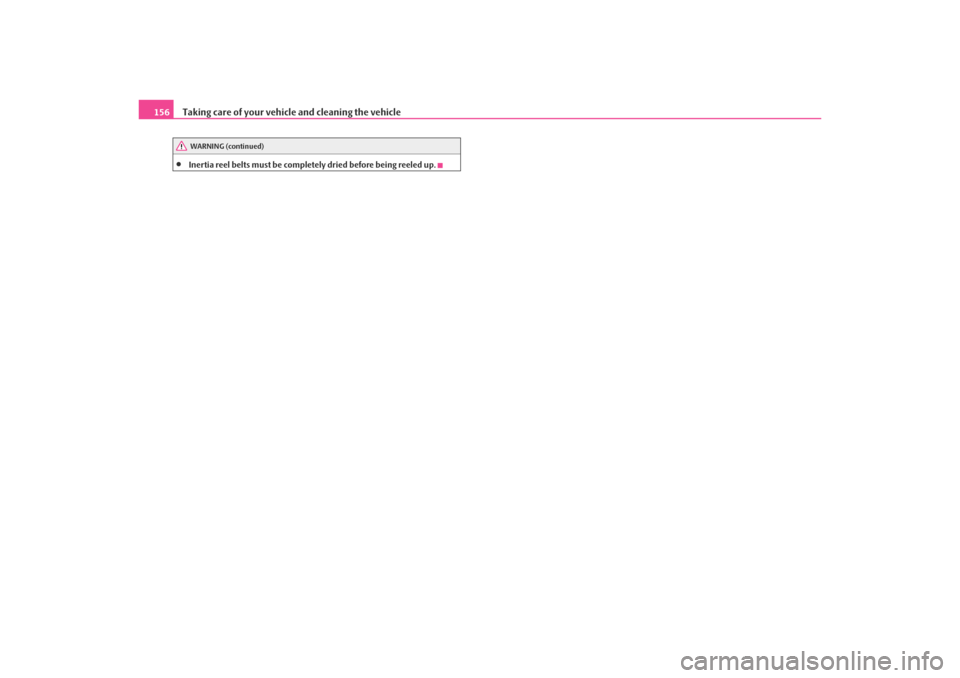
Taking care of your vehicle and cleaning the vehicle
156•
Inertia reel belts must be complete ly dried before being reeled up.WARNING (continued)
s2ig.book Page 156 Monday, November 10, 2008 11:20 AM
Page 158 of 226
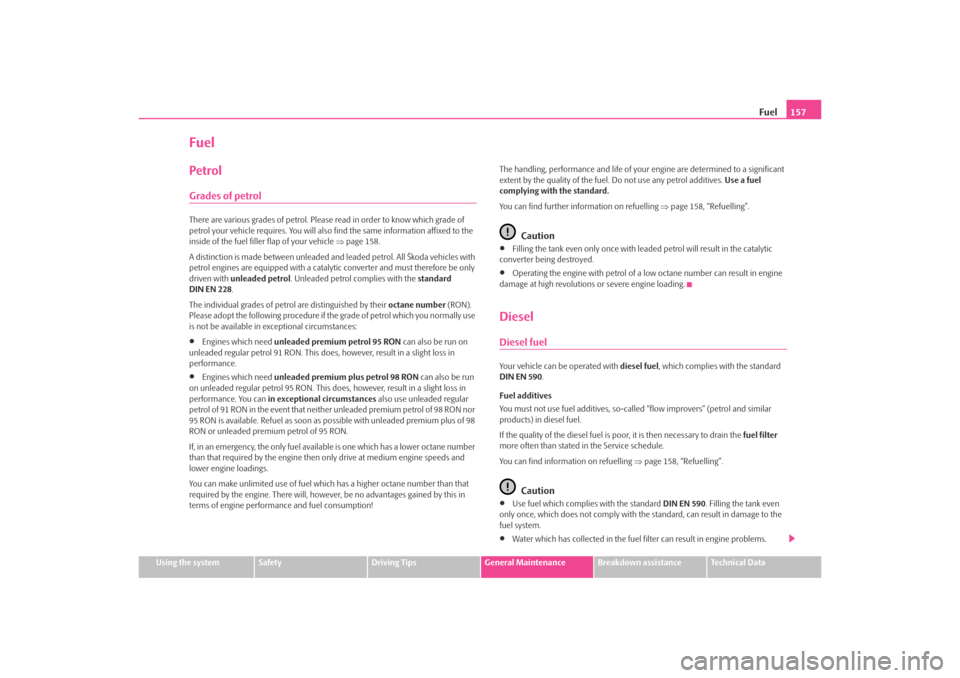
Fuel157
Using the system
Safety
Driving Tips
General Maintenance
Breakdown assistance
Technical Data
FuelPetrolGrades of petrolThere are various grades of petrol. Please read in order to know which grade of
petrol your vehicle requires. You will also find the same information affixed to the
inside of the fuel filler flap of your vehicle ⇒page 158.
A distinction is made between unleaded an d leaded petrol. All Škoda vehicles with
petrol engines are equipped with a catalyti c converter and must therefore be only
driven with unleaded petrol . Unleaded petrol complies with the standard
DINEN228 .
The individual grades of petr ol are distinguished by their octane number (RON).
Please adopt the following procedure if the grade of petrol which you normally use
is not be available in exceptional circumstances:•
Engines which need unleaded premium petrol 95 RON can also be run on
unleaded regular petrol 91 RON. This does, however, result in a slight loss in
performance.
•
Engines which need unleaded premium plus petrol 98 RON can also be run
on unleaded regular petrol 95 RON. This does, however, result in a slight loss in
performance. You can in exceptional circumstances also use unleaded regular
petrol of 91 RON in the event that neithe r unleaded premium petrol of 98 RON nor
95 RON is available. Refuel as soon as possible with unleaded premium plus of 98
RON or unleaded premium petrol of 95 RON.
If, in an emergency, the only fuel availa ble is one which has a lower octane number
than that required by the engine then only drive at medium engine speeds and
lower engine loadings.
You can make unlimited use of fuel whic h has a higher octane number than that
required by the engine. There will, howeve r, be no advantages gained by this in
terms of engine performance and fuel consumption! The handling, performance and life of your engine are determined to a significant
extent by the quality of the fuel.
Do not use any petrol additives. Use a fuel
complying with the standard.
You can find further information on refuelling ⇒page 158, “Refuelling”.
Caution
•
Filling the tank even only once with lead ed petrol will result in the catalytic
converter being destroyed.
•
Operating the engine with petrol of a lo w octane number can result in engine
damage at high revolutions or severe engine loading.
DieselDiesel fuelYour vehicle can be operated with diesel fuel, which complies with the standard
DIN EN 590 .
Fuel additives
You must not use fuel additives, so-called “flow improvers” (petrol and similar
products) in diesel fuel.
If the quality of the diesel fuel is poor, it is then necessary to drain the fuel filter
more often than stated in the Service schedule.
You can find information on refuelling ⇒page 158, “Refuelling”.
Caution
•
Use fuel which complies with the standard DIN EN 590. Filling the tank even
only once, which does not comply with th e standard, can result in damage to the
fuel system.
•
Water which has collected in the fuel fi lter can result in engine problems.
s2ig.book Page 157 Monday, November 10, 2008 11:20 AM
Page 159 of 226
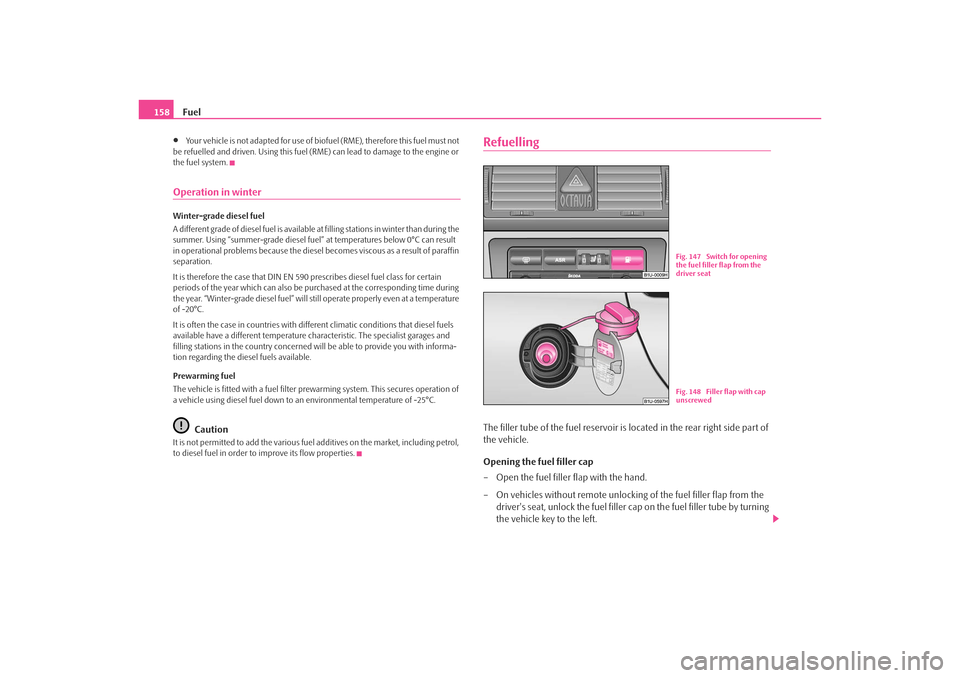
Fuel
158•
Your vehicle is not adapted for use of biof uel (RME), therefore this fuel must not
be refuelled and driven. Using this fuel (R ME) can lead to damage to the engine or
the fuel system.
Operation in winterWinter-grade diesel fuel
A different grade of diesel fuel is available at filling stations in winter than during the
summer. Using “summer-grade diesel fuel” at temperatures below 0°C can result
in operational problems because the diesel becomes viscous as a result of paraffin
separation.
It is therefore the case that DIN EN 590 prescribes diesel fuel class for certain
periods of the year which can also be pu rchased at the corresponding time during
the year. “Winter-grade diesel fuel” will still operate properly even at a temperature
of -20°C.
It is often the case in countries with diff erent climatic conditions that diesel fuels
available have a different temperature characteristic. The specialist garages and
filling stations in the country concerned wi ll be able to provide you with informa-
tion regarding the diesel fuels available.
Prewarming fuel
The vehicle is fitted with a fuel filter prewarming system. This secures operation of
a vehicle using diesel fuel down to an environmental temperature of -25°C.
Caution
It is not permitted to add the various fuel additives on the market, including petrol,
to diesel fuel in order to improve its flow properties.
RefuellingThe filler tube of the fuel reservoir is located in the rear right side part of
the vehicle.
Opening the fuel filler cap
– Open the fuel filler flap with the hand.
– On vehicles without remote unlocking of the fuel filler flap from the
driver's seat, unlock the fuel filler cap on the fuel filler tube by turning
the vehicle key to the left.
Fig. 147 Switch for opening
the fuel filler flap from the
driver seatFig. 148 Filler flap with cap
unscrewed
s2ig.book Page 158 Monday, November 10, 2008 11:20 AM
Page 160 of 226
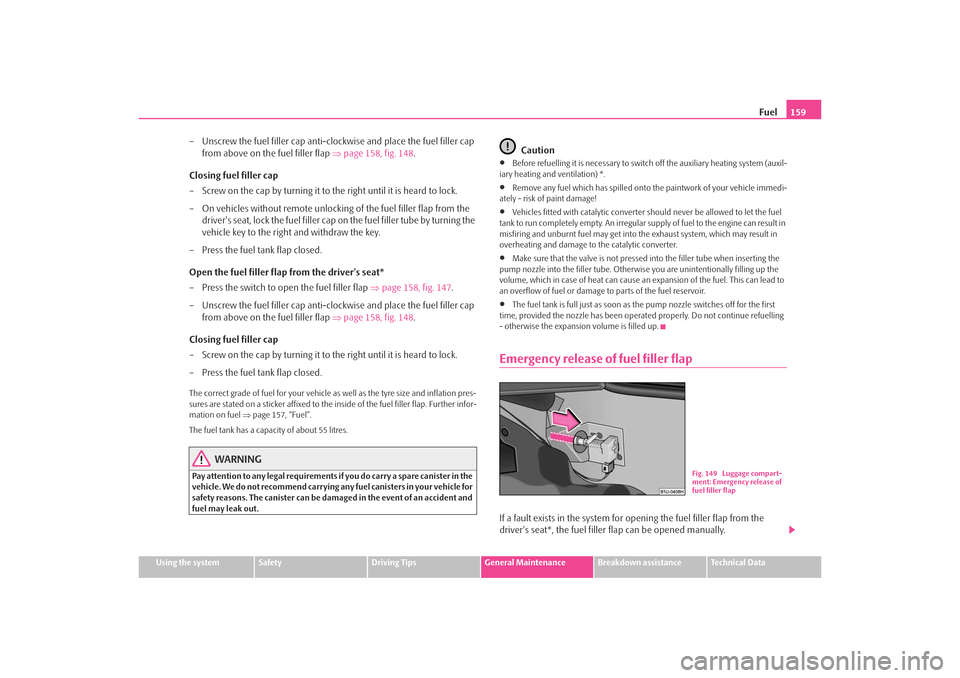
Fuel159
Using the system
Safety
Driving Tips
General Maintenance
Breakdown assistance
Technical Data
– Unscrew the fuel filler cap anti-cl ockwise and place the fuel filler cap
from above on the fuel filler flap ⇒page 158, fig. 148 .
Closing fuel filler cap
– Screw on the cap by turning it to the right until it is heard to lock.
– On vehicles without remote unlocking of the fuel filler flap from the driver's seat, lock the fuel filler cap on the fuel filler tube by turning the
vehicle key to the right and withdraw the key.
– Press the fuel tank flap closed.
Open the fuel filler flap from the driver's seat*
– Press the switch to open the fuel filler flap ⇒page 158, fig. 147 .
– Unscrew the fuel filler cap anti-cl ockwise and place the fuel filler cap
from above on the fuel filler flap ⇒page 158, fig. 148 .
Closing fuel filler cap
– Screw on the cap by turning it to the right until it is heard to lock.
– Press the fuel tank flap closed.The correct grade of fuel for your vehicle as well as the tyre size and inflation pres-
sures are stated on a sticker affixed to the inside of the fuel filler flap. Further infor-
mation on fuel ⇒page 157, “Fuel”.
The fuel tank has a capacity of about 55 litres.
WARNING
Pay attention to any legal requirements if you do carry a spare canister in the
vehicle. We do not recommend carrying any fuel canisters in your vehicle for
safety reasons. The canister can be da maged in the event of an accident and
fuel may leak out.
Caution
•
Before refuelling it is necessary to switch off the auxiliary heating system (auxil-
iary heating and ventilation) *.
•
Remove any fuel which has spilled onto the paintwork of your vehicle immedi-
ately - risk of paint damage!
•
Vehicles fitted with catalytic converter should never be allowed to let the fuel
tank to run completely empty. An irregular supply of fuel to the engine can result in
misfiring and unburnt fuel may get into the exhaust system, which may result in
overheating and damage to the catalytic converter.
•
Make sure that the valve is not pressed into the filler tube when inserting the
pump nozzle into the filler tube. Otherwis e you are unintentionally filling up the
volume, which in case of heat can cause an expansion of the fuel. This can lead to
an overflow of fuel or damage to parts of the fuel reservoir.
•
The fuel tank is full just as soon as the pump nozzle switches off for the first
time, provided the nozzle has been operated properly. Do not continue refuelling
- otherwise the expansio n volume is filled up.
Emergency release of fuel filler flapIf a fault exists in the system for opening the fuel filler flap from the
driver's seat*, the fuel filler flap can be opened manually.
Fig. 149 Luggage compart-
ment: Emergency release of
fuel filler flap
s2ig.book Page 159 Monday, November 10, 2008 11:20 AM